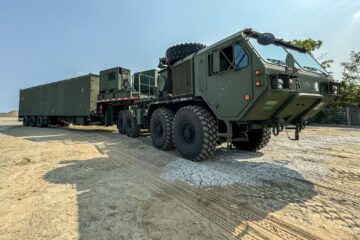Lockheed Martin is developing a brand new Vertical Launching System (VLS) for the U.S. Navy’s Next-Generation Guided-Missile Destroyer program, also known as DDG(X). A company official revealed the preliminary details of the VLS to Naval News during an interview at Sea Air Space 2023 (SAS 2023).
The new VLS is called Growth-VLS (G-VLS), a completely new and separate VLS from Lockheed Martin’s Mk.41 series of launchers. As this is a relatively new development by Lockheed Martin, Naval News could not obtain photos or concepts of the launcher.
“We call it Growth VLS. If you look at the requirements that we do research on the DDG(X), it says that it needs to have a traditional Mk.41 VLS, and that it needs to have a larger VLS that can have greater depth and larger diameter missiles stored in it. So Lockheed Martin, when they saw those requirements a couple of years ago, started investment.”

G-VLS
Development on the system comes from one of the capabilities seen from DDG(X)’s concept, specifically that of “Large Missile Launcher cells.” These new cells are to support future missiles, such as hypersonics, that could not be supported by the existing Mk.41 VLS series due to width, depth, and other constraints. When asked what dimensions they were working with for DDG(X)’s new VLS cells, Lockheed Martin stated that the Navy did not specify and that they were designing G-VLS based “off their own research.”

The Lockheed Martin official emphasized that G-VLS could support the packing of multiple traditionally cell-sized missiles from the Mk.41 VLS, such as the Standard Missile family of missiles.
“But as part of being able to do a larger diameter missile, you could say take an eight-cell Mk.41 out, put what would be a four-cell with an exhaust on it. But those four cells would be able to handle quad packs of traditional missile canister-sized, or potentially larger missiles that will be coming in the future. So that’s part of one of the things we’re investing in that will help us maximize what you can do from your loadout perspectives and potentially even increase. Because if you think about it, with a four-cell quad pack that’s sixteen and more than the eight that were originally there, just because we changed the structure.”

The G-VLS is in the early stages of development, with technologies being taken away from existing VLS such as the ground-based Mid-Range Capability and the Single Cell Launcher
“Deleveraging what happened on MRC with a cylindrical exhaust, and some of the modifications that are part of the single-side VLS, that can be applied into a naval solution.”
G-VLS is being constructed this year for tests, although the Lockheed Martin official stated that these tests were only for fit checks and that no firing from the launcher would take place.






